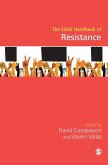The Sage Handbook of Research Methods in Political Science and International Relations
Herausgegeben:Curini, Luigi; Franzese, Robert
The Sage Handbook of Research Methods in Political Science and International Relations
Herausgegeben:Curini, Luigi; Franzese, Robert
- Gebundenes Buch
- Merkliste
- Auf die Merkliste
- Bewerten Bewerten
- Teilen
- Produkt teilen
- Produkterinnerung
- Produkterinnerung
The SAGE Handbook of Research Methods in Political Science and International Relations offers a comprehensive overview of research processes in social science from the ideation and design of research projects, through the construction of theoretical arguments, to conceptualization, measurement, & data collection, and quantitative & qualitative empirical analysis exposited through 65 major new contributions from leading international methodologists.
Each chapter surveys, builds upon, and extends the modern state of the art in its area. Following through its six-part organization,…mehr
Andere Kunden interessierten sich auch für
![The Sage Handbook of Political Science The Sage Handbook of Political Science]() The Sage Handbook of Political Science803,99 €
The Sage Handbook of Political Science803,99 €![The SAGE Handbook of the History, Philosophy and Sociology of International Relations The SAGE Handbook of the History, Philosophy and Sociology of International Relations]() The SAGE Handbook of the History, Philosophy and Sociology of International Relations155,99 €
The SAGE Handbook of the History, Philosophy and Sociology of International Relations155,99 €![The Sage Handbook of Electoral Behaviour The Sage Handbook of Electoral Behaviour]() The Sage Handbook of Electoral Behaviour487,99 €
The Sage Handbook of Electoral Behaviour487,99 €![The SAGE Handbook of Comparative Politics The SAGE Handbook of Comparative Politics]() The SAGE Handbook of Comparative Politics155,99 €
The SAGE Handbook of Comparative Politics155,99 €![The Sage Handbook of Asian Foreign Policy The Sage Handbook of Asian Foreign Policy]() The Sage Handbook of Asian Foreign Policy535,99 €
The Sage Handbook of Asian Foreign Policy535,99 €![The SAGE Handbook of Public Administration The SAGE Handbook of Public Administration]() The SAGE Handbook of Public Administration38,99 €
The SAGE Handbook of Public Administration38,99 €![The SAGE Handbook of Resistance The SAGE Handbook of Resistance]() The SAGE Handbook of Resistance155,99 €
The SAGE Handbook of Resistance155,99 €-
-
-
The SAGE Handbook of Research Methods in Political Science and International Relations offers a comprehensive overview of research processes in social science from the ideation and design of research projects, through the construction of theoretical arguments, to conceptualization, measurement, & data collection, and quantitative & qualitative empirical analysis exposited through 65 major new contributions from leading international methodologists.
Each chapter surveys, builds upon, and extends the modern state of the art in its area. Following through its six-part organization, undergraduate and graduate students, researchers and practicing academics will be guided through the design, methods, and analysis of issues in Political Science and International Relations:
Part One: Formulating Good Research Questions & Designing Good Research Projects
Part Two: Methods of Theoretical Argumentation
Part Three: Conceptualization & Measurement
Part Four: Large-Scale Data Collection & Representation Methods
Part Five: Quantitative-Empirical Methods
Part Six: Qualitative & Mixed Methods
Hinweis: Dieser Artikel kann nur an eine deutsche Lieferadresse ausgeliefert werden.
Each chapter surveys, builds upon, and extends the modern state of the art in its area. Following through its six-part organization, undergraduate and graduate students, researchers and practicing academics will be guided through the design, methods, and analysis of issues in Political Science and International Relations:
Part One: Formulating Good Research Questions & Designing Good Research Projects
Part Two: Methods of Theoretical Argumentation
Part Three: Conceptualization & Measurement
Part Four: Large-Scale Data Collection & Representation Methods
Part Five: Quantitative-Empirical Methods
Part Six: Qualitative & Mixed Methods
Hinweis: Dieser Artikel kann nur an eine deutsche Lieferadresse ausgeliefert werden.
Produktdetails
- Produktdetails
- Verlag: SAGE Publications Ltd / Sage Publications
- Seitenzahl: 1332
- Erscheinungstermin: 23. Oktober 2020
- Englisch
- Abmessung: 246mm x 184mm x 20mm
- Gewicht: 608g
- ISBN-13: 9781526459930
- ISBN-10: 1526459930
- Artikelnr.: 58407542
- Herstellerkennzeichnung
- Libri GmbH
- Europaallee 1
- 36244 Bad Hersfeld
- gpsr@libri.de
- Verlag: SAGE Publications Ltd / Sage Publications
- Seitenzahl: 1332
- Erscheinungstermin: 23. Oktober 2020
- Englisch
- Abmessung: 246mm x 184mm x 20mm
- Gewicht: 608g
- ISBN-13: 9781526459930
- ISBN-10: 1526459930
- Artikelnr.: 58407542
- Herstellerkennzeichnung
- Libri GmbH
- Europaallee 1
- 36244 Bad Hersfeld
- gpsr@libri.de
Preface: So You're a Grad Student Now? Maybe You Should Do This - Gary King
Part 1: Formulating Good Research Questions & Designing Good Research Projects
Chapter 1: Asking Interesting Questions - William Roberts Clark
Chapter 2: From Questions and Puzzles to Research Project - Andrea Ruggeri & Adam McCauley
Chapter 3: The Simple, the Trivial, and the Insightful: Field Dispatches from a Formal Theorist - Branislav Slantchev
Chapter 4: Evidence-Driven Computational Modeling - Ravinder Bhavnani, Karsten Donnay & Mirko Reul
Chapter 5: Taking Data Seriously in the Design of Data Science Projects - Mitchell Goist and Burt L. Monroe
Chapter 6: Designing Qualitative Research Projects: Notes on Theory Building, Case Selection, and Field Research - Ezequiel González Ocantos
Chapter 7: Theory Building for Causal Inference: EITM Research Projects - Thomas Bräuninger & Tilko Swalve
Chapter 8 EITM: Applications in Political Science and International Relations - John Aldrich & Jim Granato
Part 2: Methods of Theoretical Argumentation
Chapter 9: Political Psychology, Social Psychology and Behavioral Economics - Rose McDermott
Chapter 10: Institutional Theory and Method - Maxfield J. Peterson & B. Guy Peters
Chapter 11: Applied Game Theory: An overview and first thoughts on the use of Game Theoretic Tools - Adam Meirowitz & Kris Ramsay
Chapter 12: The Spatial-Voting Model - James Adams, Samuel Merrill III & Roi Zur
Chapter 13: New Directions in Veto Bargaining: Message Legislation, Virtue Signaling, and Electoral Accountability - Charles Cameron & Nathan Gibson
Chapter 14: Models of Coalition Politics: Recent Developments and New Directions - Lanny Martin & Georg Vanberg
Chapter 15: Models of Interstate Conflict - James Morrow & Jessica S. Sun
Chapter 16: Models of the Judiciary & Judicial Politics - Deborah Beim
Chapter 17: Wrestling with complexity in computational social science: theory, estimation, and representation - Scott De Marchi & Brandon Stewart
Chapter 18: Evaluating Approaches for Modeling Learning within Diffusion Episodes - Scott LaCombe & Frederick J. Boehmke
Part 3: Conceptualization & Measurement
Chapter 19: Conceptualization and Measurement: Basic Distinctions and Guidelines - Gerardo L. Munck, Jørgen Møller & Svend-Erik Skaaning
Chapter 20: Measurement Models - Christopher Fariss, Michael Kenwick & Kevin Reuning
Chapter 21: Measuring Attitudes - Multilevel Modeling with Post-Strati?cation (MrP) - Leemann Lucas & Fabio Wasserfallen
Part 4: Large-Scale Data Collection & Representation Methods
Chapter 22: Web data collection: Potentials and challenges - Dominic Nyhuis
Chapter 23: How to Use Social Media Data for Political Science Research - Pablo Barberá & Zachary C. Steinert-Threlkeld
Chapter 24: Spatial data - David Darmofal & Christopher Eddy
Chapter 25: Visualizing data in political science - Richard Traunmüller
Chapter 26: Text as data: an overview - Ken Benoit
Chapter 27: Scaling Political Positions from Text: Assumptions, Methods and Pitfalls - Benjamin Carl Krag Egerod & Robert Klemmensen
Chapter 28: Classification and Clustering - Sarah B. Bouchat
Chapter 29: Sentiment analysis and social media - Luigi Curini & Robert Fahey
Chapter 30: Big Relational Data: Network-Analytic Measurement - Ernesto Calvo, Joan Timoneda & Tiago Ventura
Part 5: Quantitative-Empirical Methods
Chapter 31: Econometric Modeling: From Measurement, Prediction, and Causal Inference to Causal Response Estimation - Robert Franzese
Chapter 32: A Principle Approach to Time Series Analysis - Suzanna Linn & Clayton Webb
Chapter 33: Time-Series-Cross-Section Analysis - Vera Troeger
Chapter 34: Dynamic Systems of Equations - Mark Pickup
Chapter 35: Duration Analysis - Kentaro Fukumoto
Chapter 36: Multilevel Analysis - Marco Steenbergen
Chapter 37:Selection Bias in Political Science & International Relations Applications - Tobias Böhmelt & Gabriele Spilker
Chapter 38: Dyadic Data Analysis - Eric Neumayer & Thomas Plümper
Chapter 39: Model Specification and Spatial Interdependence - Scott J. Cook, Jude C. Hays & Robert J. Franzese
Chapter 40: Instrumental variables: From structural equation models to design-based causal inference - Christopher L. Carter & Thad Dunning
Chapter 41: Causality and Design-Based Inference - Jake Bowers & Thomas Leavitt
Chapter 42: Statistical Matching with Time-Series Cross-Sectional Data: Magic, Malfeasance, or Something in Between? - Richard A. Nielsen
Chapter 43: Differences-in-Differences: Neither Natural nor an Experiment - Luke Keele
Chapter 44: The Regression Discontinuity Design - Matias D. Cattaneo, Rocío Titiunik & Gonzalo Vazquez-Bare
Chapter 45: Network-Analysis: Theory and Testing - Jennifer Victor & Elsa T. Khwaja
Chapter 46: Network Modeling: Estimation, Inference, Comparison, and Selection - John P. Schoeneman & Bruce A. Desmarais
Chapter 47: Bayesian Methods in Political Science - Jong Hee Park & Sooahn Shin
Chapter 48: Bayesian Ideal-Point Estimation - Shawn Treier
Chapter 49: Bayesian Model Selection, Model Comparison, and Model Averaging - Florian M. Hollenbach & Jacob M. Montgomery
Chapter 50: Bayesian Modeling and Inference: A Postmodern Perspective - Jeff Gill & Simon Heuberger
Chapter 51: Laboratory Experimental Methods in Political Science - Rebecca Morton & Mateo Vásquez-Cortés
Chapter 52: Field Experiments on the Frontier: Designing Better - Betsy Sinclair
Chapter 53: Field Experiments, Theory, and External Validity - Anna Maria Wilke & Macartan Humphries
Chapter 54: Survey Experiments and the Quest for Valid Interpretation - Gustavo Diaz, Christopher Grady & James H. Kuklinski
Chapter 55: Deep Learning for Political Science - Kakia Chatsiou & Slava Jankin Mikhaylov
Chapter 56: Machine Learning in Political Science: Supervised Learning Models - Kelsey Shoub & Santiago Olivella
Part 6: Qualitative & "Mixed" Methods
Chapter 57: Set theoretic methods - Adrian Du?a
Chapter 58: Mixed-methods design - Imke Harbers & Matthew C. Ingram
Chapter 59: Case study methods: case selection and case analysis - Chiara Ruffa
Chapter 60: Comparative Analyses of Foreign Policy - Klaus Brummer
Chapter 61: When Talk Isn't Cheap: Opportunities and Challenges in Interview Research - Claire Greenstein & Layna Mosley
Chapter 62: Focus Groups: From Qualitative Data Generation to Analysis - Virginie Van Ingelgom
Chapter 63: Interpretive Approaches in Political Science and International Relations - Xymena Kurowska & Berit Bliesemann de Guevara
Part 1: Formulating Good Research Questions & Designing Good Research Projects
Chapter 1: Asking Interesting Questions - William Roberts Clark
Chapter 2: From Questions and Puzzles to Research Project - Andrea Ruggeri & Adam McCauley
Chapter 3: The Simple, the Trivial, and the Insightful: Field Dispatches from a Formal Theorist - Branislav Slantchev
Chapter 4: Evidence-Driven Computational Modeling - Ravinder Bhavnani, Karsten Donnay & Mirko Reul
Chapter 5: Taking Data Seriously in the Design of Data Science Projects - Mitchell Goist and Burt L. Monroe
Chapter 6: Designing Qualitative Research Projects: Notes on Theory Building, Case Selection, and Field Research - Ezequiel González Ocantos
Chapter 7: Theory Building for Causal Inference: EITM Research Projects - Thomas Bräuninger & Tilko Swalve
Chapter 8 EITM: Applications in Political Science and International Relations - John Aldrich & Jim Granato
Part 2: Methods of Theoretical Argumentation
Chapter 9: Political Psychology, Social Psychology and Behavioral Economics - Rose McDermott
Chapter 10: Institutional Theory and Method - Maxfield J. Peterson & B. Guy Peters
Chapter 11: Applied Game Theory: An overview and first thoughts on the use of Game Theoretic Tools - Adam Meirowitz & Kris Ramsay
Chapter 12: The Spatial-Voting Model - James Adams, Samuel Merrill III & Roi Zur
Chapter 13: New Directions in Veto Bargaining: Message Legislation, Virtue Signaling, and Electoral Accountability - Charles Cameron & Nathan Gibson
Chapter 14: Models of Coalition Politics: Recent Developments and New Directions - Lanny Martin & Georg Vanberg
Chapter 15: Models of Interstate Conflict - James Morrow & Jessica S. Sun
Chapter 16: Models of the Judiciary & Judicial Politics - Deborah Beim
Chapter 17: Wrestling with complexity in computational social science: theory, estimation, and representation - Scott De Marchi & Brandon Stewart
Chapter 18: Evaluating Approaches for Modeling Learning within Diffusion Episodes - Scott LaCombe & Frederick J. Boehmke
Part 3: Conceptualization & Measurement
Chapter 19: Conceptualization and Measurement: Basic Distinctions and Guidelines - Gerardo L. Munck, Jørgen Møller & Svend-Erik Skaaning
Chapter 20: Measurement Models - Christopher Fariss, Michael Kenwick & Kevin Reuning
Chapter 21: Measuring Attitudes - Multilevel Modeling with Post-Strati?cation (MrP) - Leemann Lucas & Fabio Wasserfallen
Part 4: Large-Scale Data Collection & Representation Methods
Chapter 22: Web data collection: Potentials and challenges - Dominic Nyhuis
Chapter 23: How to Use Social Media Data for Political Science Research - Pablo Barberá & Zachary C. Steinert-Threlkeld
Chapter 24: Spatial data - David Darmofal & Christopher Eddy
Chapter 25: Visualizing data in political science - Richard Traunmüller
Chapter 26: Text as data: an overview - Ken Benoit
Chapter 27: Scaling Political Positions from Text: Assumptions, Methods and Pitfalls - Benjamin Carl Krag Egerod & Robert Klemmensen
Chapter 28: Classification and Clustering - Sarah B. Bouchat
Chapter 29: Sentiment analysis and social media - Luigi Curini & Robert Fahey
Chapter 30: Big Relational Data: Network-Analytic Measurement - Ernesto Calvo, Joan Timoneda & Tiago Ventura
Part 5: Quantitative-Empirical Methods
Chapter 31: Econometric Modeling: From Measurement, Prediction, and Causal Inference to Causal Response Estimation - Robert Franzese
Chapter 32: A Principle Approach to Time Series Analysis - Suzanna Linn & Clayton Webb
Chapter 33: Time-Series-Cross-Section Analysis - Vera Troeger
Chapter 34: Dynamic Systems of Equations - Mark Pickup
Chapter 35: Duration Analysis - Kentaro Fukumoto
Chapter 36: Multilevel Analysis - Marco Steenbergen
Chapter 37:Selection Bias in Political Science & International Relations Applications - Tobias Böhmelt & Gabriele Spilker
Chapter 38: Dyadic Data Analysis - Eric Neumayer & Thomas Plümper
Chapter 39: Model Specification and Spatial Interdependence - Scott J. Cook, Jude C. Hays & Robert J. Franzese
Chapter 40: Instrumental variables: From structural equation models to design-based causal inference - Christopher L. Carter & Thad Dunning
Chapter 41: Causality and Design-Based Inference - Jake Bowers & Thomas Leavitt
Chapter 42: Statistical Matching with Time-Series Cross-Sectional Data: Magic, Malfeasance, or Something in Between? - Richard A. Nielsen
Chapter 43: Differences-in-Differences: Neither Natural nor an Experiment - Luke Keele
Chapter 44: The Regression Discontinuity Design - Matias D. Cattaneo, Rocío Titiunik & Gonzalo Vazquez-Bare
Chapter 45: Network-Analysis: Theory and Testing - Jennifer Victor & Elsa T. Khwaja
Chapter 46: Network Modeling: Estimation, Inference, Comparison, and Selection - John P. Schoeneman & Bruce A. Desmarais
Chapter 47: Bayesian Methods in Political Science - Jong Hee Park & Sooahn Shin
Chapter 48: Bayesian Ideal-Point Estimation - Shawn Treier
Chapter 49: Bayesian Model Selection, Model Comparison, and Model Averaging - Florian M. Hollenbach & Jacob M. Montgomery
Chapter 50: Bayesian Modeling and Inference: A Postmodern Perspective - Jeff Gill & Simon Heuberger
Chapter 51: Laboratory Experimental Methods in Political Science - Rebecca Morton & Mateo Vásquez-Cortés
Chapter 52: Field Experiments on the Frontier: Designing Better - Betsy Sinclair
Chapter 53: Field Experiments, Theory, and External Validity - Anna Maria Wilke & Macartan Humphries
Chapter 54: Survey Experiments and the Quest for Valid Interpretation - Gustavo Diaz, Christopher Grady & James H. Kuklinski
Chapter 55: Deep Learning for Political Science - Kakia Chatsiou & Slava Jankin Mikhaylov
Chapter 56: Machine Learning in Political Science: Supervised Learning Models - Kelsey Shoub & Santiago Olivella
Part 6: Qualitative & "Mixed" Methods
Chapter 57: Set theoretic methods - Adrian Du?a
Chapter 58: Mixed-methods design - Imke Harbers & Matthew C. Ingram
Chapter 59: Case study methods: case selection and case analysis - Chiara Ruffa
Chapter 60: Comparative Analyses of Foreign Policy - Klaus Brummer
Chapter 61: When Talk Isn't Cheap: Opportunities and Challenges in Interview Research - Claire Greenstein & Layna Mosley
Chapter 62: Focus Groups: From Qualitative Data Generation to Analysis - Virginie Van Ingelgom
Chapter 63: Interpretive Approaches in Political Science and International Relations - Xymena Kurowska & Berit Bliesemann de Guevara
Preface: So You're a Grad Student Now? Maybe You Should Do This - Gary King
Part 1: Formulating Good Research Questions & Designing Good Research Projects
Chapter 1: Asking Interesting Questions - William Roberts Clark
Chapter 2: From Questions and Puzzles to Research Project - Andrea Ruggeri & Adam McCauley
Chapter 3: The Simple, the Trivial, and the Insightful: Field Dispatches from a Formal Theorist - Branislav Slantchev
Chapter 4: Evidence-Driven Computational Modeling - Ravinder Bhavnani, Karsten Donnay & Mirko Reul
Chapter 5: Taking Data Seriously in the Design of Data Science Projects - Mitchell Goist and Burt L. Monroe
Chapter 6: Designing Qualitative Research Projects: Notes on Theory Building, Case Selection, and Field Research - Ezequiel González Ocantos
Chapter 7: Theory Building for Causal Inference: EITM Research Projects - Thomas Bräuninger & Tilko Swalve
Chapter 8 EITM: Applications in Political Science and International Relations - John Aldrich & Jim Granato
Part 2: Methods of Theoretical Argumentation
Chapter 9: Political Psychology, Social Psychology and Behavioral Economics - Rose McDermott
Chapter 10: Institutional Theory and Method - Maxfield J. Peterson & B. Guy Peters
Chapter 11: Applied Game Theory: An overview and first thoughts on the use of Game Theoretic Tools - Adam Meirowitz & Kris Ramsay
Chapter 12: The Spatial-Voting Model - James Adams, Samuel Merrill III & Roi Zur
Chapter 13: New Directions in Veto Bargaining: Message Legislation, Virtue Signaling, and Electoral Accountability - Charles Cameron & Nathan Gibson
Chapter 14: Models of Coalition Politics: Recent Developments and New Directions - Lanny Martin & Georg Vanberg
Chapter 15: Models of Interstate Conflict - James Morrow & Jessica S. Sun
Chapter 16: Models of the Judiciary & Judicial Politics - Deborah Beim
Chapter 17: Wrestling with complexity in computational social science: theory, estimation, and representation - Scott De Marchi & Brandon Stewart
Chapter 18: Evaluating Approaches for Modeling Learning within Diffusion Episodes - Scott LaCombe & Frederick J. Boehmke
Part 3: Conceptualization & Measurement
Chapter 19: Conceptualization and Measurement: Basic Distinctions and Guidelines - Gerardo L. Munck, Jørgen Møller & Svend-Erik Skaaning
Chapter 20: Measurement Models - Christopher Fariss, Michael Kenwick & Kevin Reuning
Chapter 21: Measuring Attitudes - Multilevel Modeling with Post-Strati?cation (MrP) - Leemann Lucas & Fabio Wasserfallen
Part 4: Large-Scale Data Collection & Representation Methods
Chapter 22: Web data collection: Potentials and challenges - Dominic Nyhuis
Chapter 23: How to Use Social Media Data for Political Science Research - Pablo Barberá & Zachary C. Steinert-Threlkeld
Chapter 24: Spatial data - David Darmofal & Christopher Eddy
Chapter 25: Visualizing data in political science - Richard Traunmüller
Chapter 26: Text as data: an overview - Ken Benoit
Chapter 27: Scaling Political Positions from Text: Assumptions, Methods and Pitfalls - Benjamin Carl Krag Egerod & Robert Klemmensen
Chapter 28: Classification and Clustering - Sarah B. Bouchat
Chapter 29: Sentiment analysis and social media - Luigi Curini & Robert Fahey
Chapter 30: Big Relational Data: Network-Analytic Measurement - Ernesto Calvo, Joan Timoneda & Tiago Ventura
Part 5: Quantitative-Empirical Methods
Chapter 31: Econometric Modeling: From Measurement, Prediction, and Causal Inference to Causal Response Estimation - Robert Franzese
Chapter 32: A Principle Approach to Time Series Analysis - Suzanna Linn & Clayton Webb
Chapter 33: Time-Series-Cross-Section Analysis - Vera Troeger
Chapter 34: Dynamic Systems of Equations - Mark Pickup
Chapter 35: Duration Analysis - Kentaro Fukumoto
Chapter 36: Multilevel Analysis - Marco Steenbergen
Chapter 37:Selection Bias in Political Science & International Relations Applications - Tobias Böhmelt & Gabriele Spilker
Chapter 38: Dyadic Data Analysis - Eric Neumayer & Thomas Plümper
Chapter 39: Model Specification and Spatial Interdependence - Scott J. Cook, Jude C. Hays & Robert J. Franzese
Chapter 40: Instrumental variables: From structural equation models to design-based causal inference - Christopher L. Carter & Thad Dunning
Chapter 41: Causality and Design-Based Inference - Jake Bowers & Thomas Leavitt
Chapter 42: Statistical Matching with Time-Series Cross-Sectional Data: Magic, Malfeasance, or Something in Between? - Richard A. Nielsen
Chapter 43: Differences-in-Differences: Neither Natural nor an Experiment - Luke Keele
Chapter 44: The Regression Discontinuity Design - Matias D. Cattaneo, Rocío Titiunik & Gonzalo Vazquez-Bare
Chapter 45: Network-Analysis: Theory and Testing - Jennifer Victor & Elsa T. Khwaja
Chapter 46: Network Modeling: Estimation, Inference, Comparison, and Selection - John P. Schoeneman & Bruce A. Desmarais
Chapter 47: Bayesian Methods in Political Science - Jong Hee Park & Sooahn Shin
Chapter 48: Bayesian Ideal-Point Estimation - Shawn Treier
Chapter 49: Bayesian Model Selection, Model Comparison, and Model Averaging - Florian M. Hollenbach & Jacob M. Montgomery
Chapter 50: Bayesian Modeling and Inference: A Postmodern Perspective - Jeff Gill & Simon Heuberger
Chapter 51: Laboratory Experimental Methods in Political Science - Rebecca Morton & Mateo Vásquez-Cortés
Chapter 52: Field Experiments on the Frontier: Designing Better - Betsy Sinclair
Chapter 53: Field Experiments, Theory, and External Validity - Anna Maria Wilke & Macartan Humphries
Chapter 54: Survey Experiments and the Quest for Valid Interpretation - Gustavo Diaz, Christopher Grady & James H. Kuklinski
Chapter 55: Deep Learning for Political Science - Kakia Chatsiou & Slava Jankin Mikhaylov
Chapter 56: Machine Learning in Political Science: Supervised Learning Models - Kelsey Shoub & Santiago Olivella
Part 6: Qualitative & "Mixed" Methods
Chapter 57: Set theoretic methods - Adrian Du?a
Chapter 58: Mixed-methods design - Imke Harbers & Matthew C. Ingram
Chapter 59: Case study methods: case selection and case analysis - Chiara Ruffa
Chapter 60: Comparative Analyses of Foreign Policy - Klaus Brummer
Chapter 61: When Talk Isn't Cheap: Opportunities and Challenges in Interview Research - Claire Greenstein & Layna Mosley
Chapter 62: Focus Groups: From Qualitative Data Generation to Analysis - Virginie Van Ingelgom
Chapter 63: Interpretive Approaches in Political Science and International Relations - Xymena Kurowska & Berit Bliesemann de Guevara
Part 1: Formulating Good Research Questions & Designing Good Research Projects
Chapter 1: Asking Interesting Questions - William Roberts Clark
Chapter 2: From Questions and Puzzles to Research Project - Andrea Ruggeri & Adam McCauley
Chapter 3: The Simple, the Trivial, and the Insightful: Field Dispatches from a Formal Theorist - Branislav Slantchev
Chapter 4: Evidence-Driven Computational Modeling - Ravinder Bhavnani, Karsten Donnay & Mirko Reul
Chapter 5: Taking Data Seriously in the Design of Data Science Projects - Mitchell Goist and Burt L. Monroe
Chapter 6: Designing Qualitative Research Projects: Notes on Theory Building, Case Selection, and Field Research - Ezequiel González Ocantos
Chapter 7: Theory Building for Causal Inference: EITM Research Projects - Thomas Bräuninger & Tilko Swalve
Chapter 8 EITM: Applications in Political Science and International Relations - John Aldrich & Jim Granato
Part 2: Methods of Theoretical Argumentation
Chapter 9: Political Psychology, Social Psychology and Behavioral Economics - Rose McDermott
Chapter 10: Institutional Theory and Method - Maxfield J. Peterson & B. Guy Peters
Chapter 11: Applied Game Theory: An overview and first thoughts on the use of Game Theoretic Tools - Adam Meirowitz & Kris Ramsay
Chapter 12: The Spatial-Voting Model - James Adams, Samuel Merrill III & Roi Zur
Chapter 13: New Directions in Veto Bargaining: Message Legislation, Virtue Signaling, and Electoral Accountability - Charles Cameron & Nathan Gibson
Chapter 14: Models of Coalition Politics: Recent Developments and New Directions - Lanny Martin & Georg Vanberg
Chapter 15: Models of Interstate Conflict - James Morrow & Jessica S. Sun
Chapter 16: Models of the Judiciary & Judicial Politics - Deborah Beim
Chapter 17: Wrestling with complexity in computational social science: theory, estimation, and representation - Scott De Marchi & Brandon Stewart
Chapter 18: Evaluating Approaches for Modeling Learning within Diffusion Episodes - Scott LaCombe & Frederick J. Boehmke
Part 3: Conceptualization & Measurement
Chapter 19: Conceptualization and Measurement: Basic Distinctions and Guidelines - Gerardo L. Munck, Jørgen Møller & Svend-Erik Skaaning
Chapter 20: Measurement Models - Christopher Fariss, Michael Kenwick & Kevin Reuning
Chapter 21: Measuring Attitudes - Multilevel Modeling with Post-Strati?cation (MrP) - Leemann Lucas & Fabio Wasserfallen
Part 4: Large-Scale Data Collection & Representation Methods
Chapter 22: Web data collection: Potentials and challenges - Dominic Nyhuis
Chapter 23: How to Use Social Media Data for Political Science Research - Pablo Barberá & Zachary C. Steinert-Threlkeld
Chapter 24: Spatial data - David Darmofal & Christopher Eddy
Chapter 25: Visualizing data in political science - Richard Traunmüller
Chapter 26: Text as data: an overview - Ken Benoit
Chapter 27: Scaling Political Positions from Text: Assumptions, Methods and Pitfalls - Benjamin Carl Krag Egerod & Robert Klemmensen
Chapter 28: Classification and Clustering - Sarah B. Bouchat
Chapter 29: Sentiment analysis and social media - Luigi Curini & Robert Fahey
Chapter 30: Big Relational Data: Network-Analytic Measurement - Ernesto Calvo, Joan Timoneda & Tiago Ventura
Part 5: Quantitative-Empirical Methods
Chapter 31: Econometric Modeling: From Measurement, Prediction, and Causal Inference to Causal Response Estimation - Robert Franzese
Chapter 32: A Principle Approach to Time Series Analysis - Suzanna Linn & Clayton Webb
Chapter 33: Time-Series-Cross-Section Analysis - Vera Troeger
Chapter 34: Dynamic Systems of Equations - Mark Pickup
Chapter 35: Duration Analysis - Kentaro Fukumoto
Chapter 36: Multilevel Analysis - Marco Steenbergen
Chapter 37:Selection Bias in Political Science & International Relations Applications - Tobias Böhmelt & Gabriele Spilker
Chapter 38: Dyadic Data Analysis - Eric Neumayer & Thomas Plümper
Chapter 39: Model Specification and Spatial Interdependence - Scott J. Cook, Jude C. Hays & Robert J. Franzese
Chapter 40: Instrumental variables: From structural equation models to design-based causal inference - Christopher L. Carter & Thad Dunning
Chapter 41: Causality and Design-Based Inference - Jake Bowers & Thomas Leavitt
Chapter 42: Statistical Matching with Time-Series Cross-Sectional Data: Magic, Malfeasance, or Something in Between? - Richard A. Nielsen
Chapter 43: Differences-in-Differences: Neither Natural nor an Experiment - Luke Keele
Chapter 44: The Regression Discontinuity Design - Matias D. Cattaneo, Rocío Titiunik & Gonzalo Vazquez-Bare
Chapter 45: Network-Analysis: Theory and Testing - Jennifer Victor & Elsa T. Khwaja
Chapter 46: Network Modeling: Estimation, Inference, Comparison, and Selection - John P. Schoeneman & Bruce A. Desmarais
Chapter 47: Bayesian Methods in Political Science - Jong Hee Park & Sooahn Shin
Chapter 48: Bayesian Ideal-Point Estimation - Shawn Treier
Chapter 49: Bayesian Model Selection, Model Comparison, and Model Averaging - Florian M. Hollenbach & Jacob M. Montgomery
Chapter 50: Bayesian Modeling and Inference: A Postmodern Perspective - Jeff Gill & Simon Heuberger
Chapter 51: Laboratory Experimental Methods in Political Science - Rebecca Morton & Mateo Vásquez-Cortés
Chapter 52: Field Experiments on the Frontier: Designing Better - Betsy Sinclair
Chapter 53: Field Experiments, Theory, and External Validity - Anna Maria Wilke & Macartan Humphries
Chapter 54: Survey Experiments and the Quest for Valid Interpretation - Gustavo Diaz, Christopher Grady & James H. Kuklinski
Chapter 55: Deep Learning for Political Science - Kakia Chatsiou & Slava Jankin Mikhaylov
Chapter 56: Machine Learning in Political Science: Supervised Learning Models - Kelsey Shoub & Santiago Olivella
Part 6: Qualitative & "Mixed" Methods
Chapter 57: Set theoretic methods - Adrian Du?a
Chapter 58: Mixed-methods design - Imke Harbers & Matthew C. Ingram
Chapter 59: Case study methods: case selection and case analysis - Chiara Ruffa
Chapter 60: Comparative Analyses of Foreign Policy - Klaus Brummer
Chapter 61: When Talk Isn't Cheap: Opportunities and Challenges in Interview Research - Claire Greenstein & Layna Mosley
Chapter 62: Focus Groups: From Qualitative Data Generation to Analysis - Virginie Van Ingelgom
Chapter 63: Interpretive Approaches in Political Science and International Relations - Xymena Kurowska & Berit Bliesemann de Guevara








